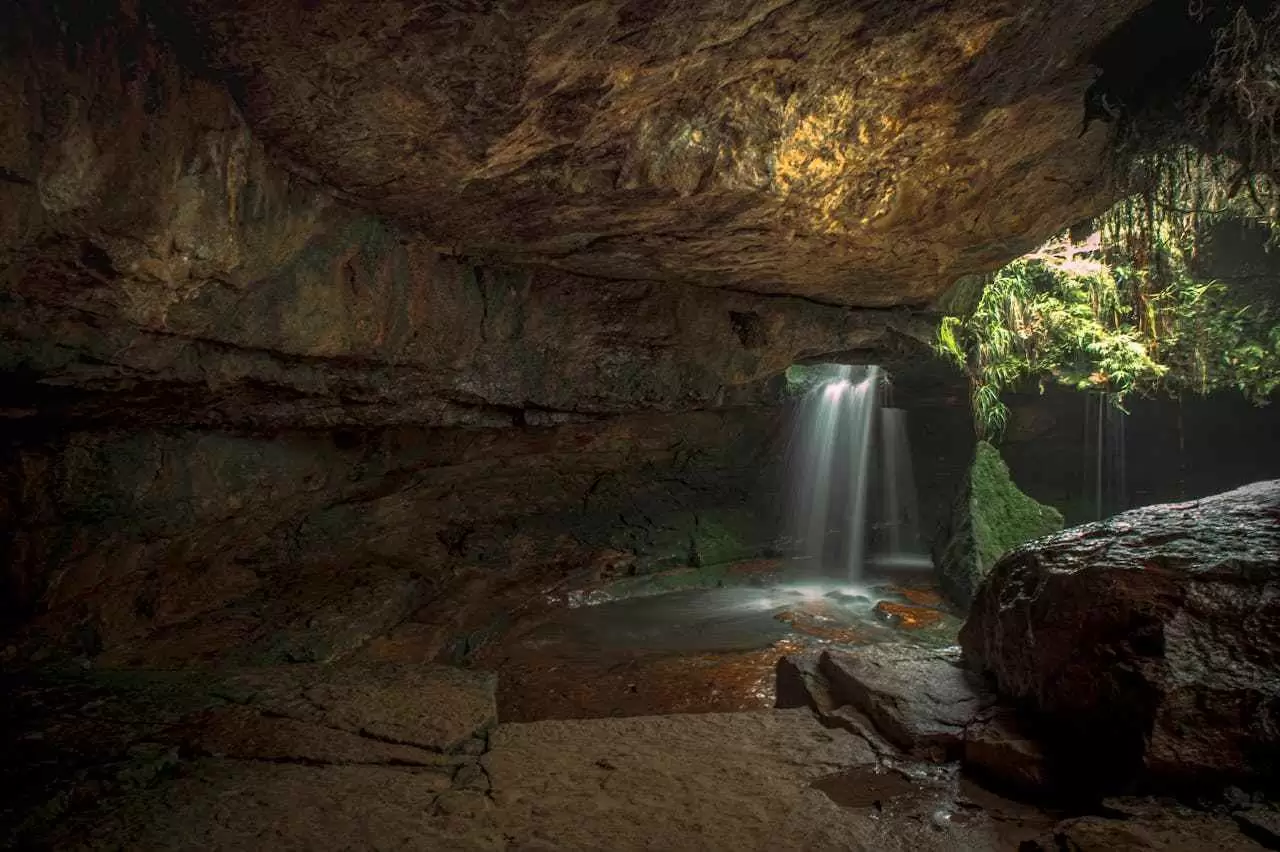
Tucked away in the hilly terrain of Cherrapunjee (Sohra), Meghalaya, Arwah Caves is one of the largest limestone caves in the region, offering a thrilling underground adventure for explorers and nature enthusiasts. Unlike the more popular Mawsmai Cave, Arwah Cave is less commercialised, providing a raw and authentic experience of Meghalaya’s subterranean wonders.
Arwah Caves are famous for their vast chambers, fascinating stalactites and stalagmites, fossilised rocks, and narrow passageways. This makes it a must-visit for adventure travellers, photographers, and geology enthusiasts looking for an offbeat experience in Northeast India.
Arwah Caves is an ideal destination for those seeking adventure, mystery, and natural beauty. Here’s why it should be on your Meghalaya itinerary:
Massive Limestone Formations: Arwah Cave features impressive stalactites, stalagmites, and rock pillars, some of which are over thousands of years old.
Adventure & Exploration: Narrow tunnels, uneven floors, and hidden chambers make it a thrilling experience for adventurers.
Fossils & Geological Wonders: Some sections of the cave display fossilised remains of prehistoric life, offering a peek into the past.
Offbeat Attraction: Less crowded than other caves, perfect for travellers seeking solitude and unique exploration.
Photography Opportunities: Dramatic lighting and mysterious rock formations make it a photographer’s paradise.
Visiting Arwah Cave is not just sightseeing; it’s a mini-adventure and a journey into Meghalaya’s geological history.
The best time to explore Arwah Cave is guided by accessibility and safety:
Spring (March–May): Pleasant weather, comfortable for trekking and exploring.
Monsoon (June–September): Cave walls are wet, and floors may be slippery. Waterfalls nearby make it scenic, but caution is advised.
Autumn (October–November): Dry season, ideal for exploration and photography.
Winter (December–February): Cool, misty atmosphere adds mystery, but some areas may be damp.
For a safe and comfortable visit, it is recommended to visit between October and May.
Navigate narrow tunnels, vast chambers, and hidden corridors.
Requires moderate physical fitness due to uneven paths and low ceilings.
A flashlight or headlamp is essential to explore darker sections safely.
Observe the stunning stalactites, stalagmites, and rock pillars that have formed over centuries.
Some formations resemble natural sculptures, providing excellent photography opportunities.
Discover fossilised rock formations in certain sections.
Discover Meghalaya’s geological history and its rich underground biodiversity.
Short trekking trails near the cave lead to lush forests, streams, and viewpoints.
Ideal for nature walks, birdwatching, and scenic photography.
Mawsmai Cave: Smaller, well-lit, and easier for first-time cavers.
Nohkalikai Falls: India’s tallest plunge waterfall is nearby.
Seven Sisters Falls: Multi-stream cascade for scenic views.
Living Root Bridges (Nongriat & Tyrna): Iconic natural bridges requiring trekking.
Arwah Cave is best visited as part of a 2–3 day Cherrapunjee adventure itinerary.
Arwah Caves are accessible by road and located near other Cherrapunjee attractions:
Around 6 km from Cherrapunjee town and 57 km from Shillong.
Taxis, shared cabs, and buses are available for transportation.
Scenic drives pass through lush hills, forests, and waterfalls, making the journey an integral part of the experience.
Nearest airport: Shillong Airport (Umroi Airport), approximately 80 km away.
From the airport, taxis can be hired to Cherrapunjee and Arwah Cave.
Nearest major railway station: Guwahati, around 170 km away.
From Guwahati, take taxis or buses to Shillong, and then continue to Cherrapunjee.
Cherrapunjee Homestays & Guesthouses: Comfortable, budget-friendly, and convenient.
Eco-Resorts & Lodges: Surrounded by lush greenery, ideal for nature lovers.
Shillong Hotels: Suitable for travellers who prefer city amenities with day trips to Cherrapunjee.
Staying in Cherrapunjee allows early morning or late afternoon cave exploration, ensuring fewer crowds and better photographs.
Mawsmai Cave: Well-lit, smaller limestone cave suitable for casual explorers.
Nohkalikai Falls: Stunning plunge waterfall, just 6 km away.
Seven Sisters Falls (Nohsngithiang Falls): Iconic seven-stream waterfall.
Living Root Bridges (Nongriat & Tyrna): Natural wonders requiring moderate trekking.
Eco Park & Thangkharang Park: Scenic viewpoints for panoramic views of the region.
Arwah Cave is ideal for travellers seeking a blend of adventure, geology, and offbeat exploration.
Wear sturdy, non-slip shoes; cave floors can be wet and uneven.
Carry a headlamp or flashlight for darker sections.
Keep hands free; backpacks are more convenient than handbags.
Avoid days with heavy rainfall, as tunnels can become slippery and hazardous.
Respect cave formations; do not touch or damage stalactites/stalagmites.
Bring water, snacks, and light protective clothing for trekking.